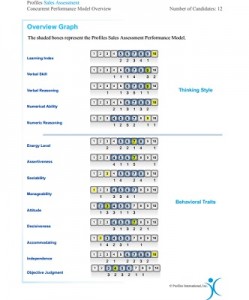Posted by on January 7, 2017.
 In this series of blog posts, we are showing real life examples of how to utilize the data from our Assessments to gain a better perspective on how you and your team might view certain situations and areas of conflict. We looked at the Sociability & Attitude Behavior sections of the Profiles Sales Assessment Concurrent Performance Model Overview and now, we want to dig deeper into the Independence section. Focusing on the Independence Behavior will provide us another excellent example of how to use this report to optimally execute and create a tension free environment for your audience.
In this series of blog posts, we are showing real life examples of how to utilize the data from our Assessments to gain a better perspective on how you and your team might view certain situations and areas of conflict. We looked at the Sociability & Attitude Behavior sections of the Profiles Sales Assessment Concurrent Performance Model Overview and now, we want to dig deeper into the Independence section. Focusing on the Independence Behavior will provide us another excellent example of how to use this report to optimally execute and create a tension free environment for your audience.
Independence measures the level of supervision people are most comfortable with. People with scores on the right prefer minimal supervision. They prefer to be informed of what is required quickly and decisively, then get out of their way and let them get it done! The perception of micro-management happens very quickly for these right oriented people. Individuals with scores on the left enjoy routine interaction with their supervisor. They like to know they are doing the right things, meeting the supervisor’s expectations and are “on the right track.”
As you can see in our team example, the leader has a 10 in Independence. Only 2.5% of the population would score here. Or said a bit differently, 97.5% of the population would be more dependent than this leader. He/she is highly independent and prefers minimal supervision. Routine interactions and follow up by this leader with their team would be quickly perceived as micro-management of his/her team by this leader. Likely, this leader prefers to treat others the way they themself like to be treated, “like and adult.” They want to provide direction and get out of the way.
7 members of this team have scores of 7 or lower reflecting a meaningful difference in the way they perceive independence. These people prefer more routine interaction with their supervisor. They want to know how they are doing and get feedback on whether they are meeting his/her expectations?
As this scenario evolves, the leader might be thinking “why do these people call me so often?” “Did I not clearly communicate?” “Don’t they want to be treated like adults?” In contrast, these 7 team members might be thinking “My boss does not speak with me very often.” “Doesn’t he/she like me?” “Did I do something to make my boss mad?” As you might suspect, this type of tension can impact the efficiency and effectiveness of this team’s performance.
By having this type of team report available, the leader can understand that in order to create the optimum environment most of their team requires more attention and interaction. The leader shouldn’t assume that by checking in and monitoring their team that the team members feel belittled or offended. The team members will now understand the high level of their leader’s independence. They will know that the leader truly respects them as adults and that they need to better control the frequency of their interactions with their supervisor. As leader and team stretch outside their comfort zones towards each other’s perspective, all will enjoy a a level of independence that they can appreciate. Optimum execution by mitigating tension!
For more information on How to Execute with ANY Audience, click here to read every blog post in this series.
